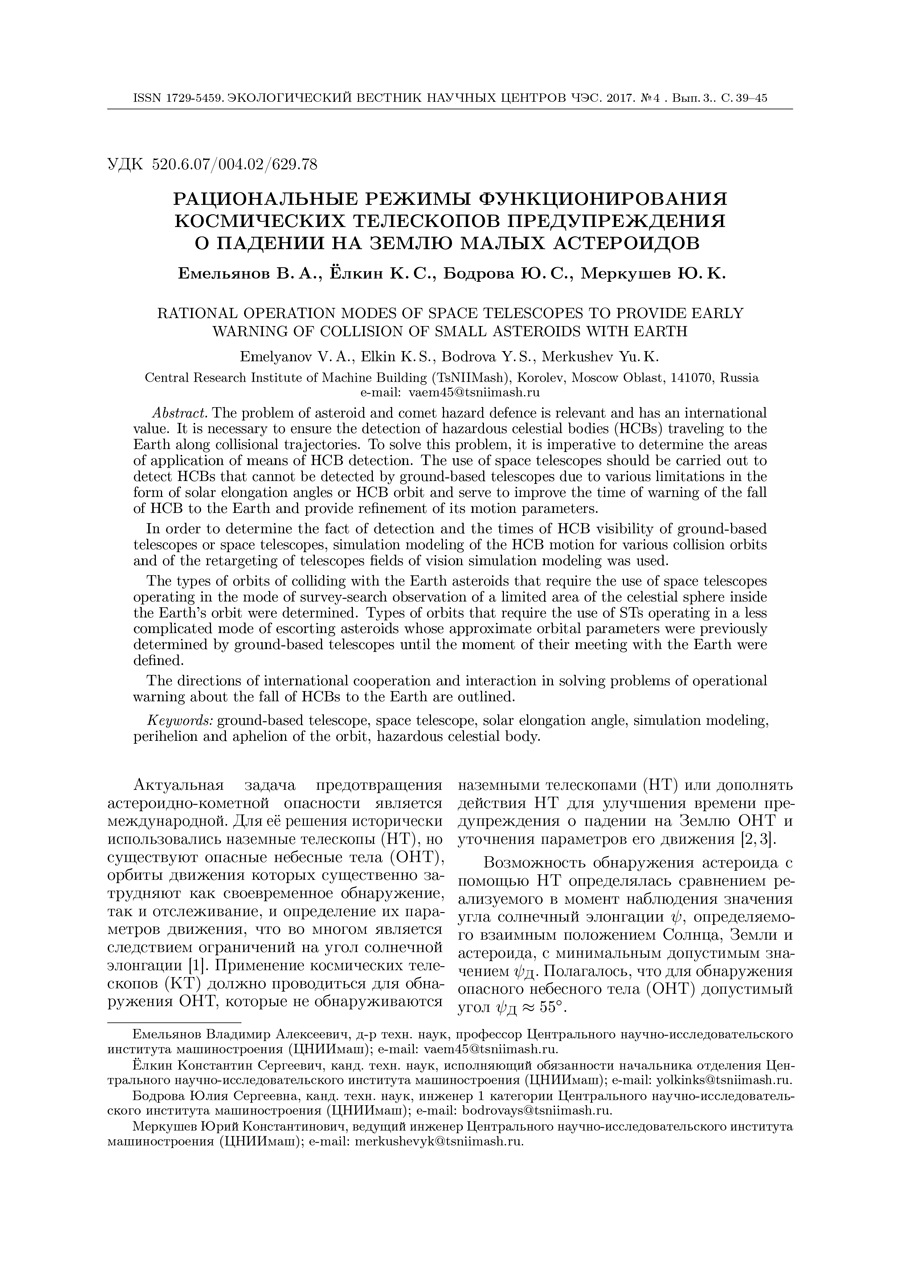Rational operation modes of space telescopes to provide early warning of collision of small asteroids with Earth
UDC
520.6.07/004.02/629.78Abstract
The problem of asteroid and comet hazard defence is relevant and has an international value. It is necessary to ensure the detection of hazardous celestial bodies (HCBs) traveling to the Earth along collisional trajectories. To solve this problem, it is imperative to determine the areas of application of means of HCB detection. The use of space telescopes should be carried out to detect HCBs that cannot be detected by ground-based telescopes due to various limitations in the form of solar elongation angles or HCB orbit and serve to improve the time of warning of the fall of HCB to the Earth and provide refinement of its motion parameters. In order to determine the fact of detection and the times of HCB visibility of ground-based telescopes or space telescopes, simulation modeling of the HCB motion for various collision orbits and of the retargeting of telescopes fields of vision simulation modeling was used. The types of orbits of colliding with the Earth asteroids that require the use of space telescopes operating in the mode of survey-search observation of a limited area of the celestial sphere inside the Earth's orbit were determined. Types of orbits that require the use of STs operating in a less complicated mode of escorting asteroids whose approximate orbital parameters were previously determined by ground-based telescopes until the moment of their meeting with the Earth were defined. The directions of international cooperation and interaction in solving problems of operational warning about the fall of HCBs to the Earth are outlined.
Keywords:
ground-based telescope, space telescope, solar elongation angle, simulation modeling, perihelion and aphelion of the orbit, hazardous celestial bodyReferences
- Shustov B.M., Shugarov A.S., Naroenkov S.A., Prokhorov M.E. Astronomicheskie aspekty kosmicheskikh ugroz: novye zadachi i podkhody k probleme asteroidno-kometnoy opasnosti posle Chelyabinskogo sobytiya 15 fevralya 2013 g. [Astronomical aspects of space threats: new tasks and approaches to the problem of asteroid-comet danger after the Chelyabinsk event February 15, 2013]. Astronomicheskiy zhurnal [Astronomical Journal], 2015, vol. 92, no. 10, pp. 867-880. (In Russian)
- Lin F., Cutry R. et al. Development of the Wide-field Infrared Survey Explorer (WISE) mission. Proc of SPIE, 2008, Vol. 7017 70170M, pp. 1-12.
- Naroenkov S.A., Shustov B.M., Emel'yanenko V.V. On the arc length of observations of small solar system body sufficient to classify it as hazardous. Cosmic Research, 2013, vol. 51, iss. 5, pp. 335-341.
- Emel'yanov V.A., Merkushev Yu.K., Ramaldanov R.P., Savel'ev M.I. Imitatsionnye modeli funktsionirovaniya kosmicheskikh teleskopov preduprezhdeniya o padenii na Zemlyu malykh ONT [Simulation models of the functioning of space telescopes warning of the fall of small ONTs to the Earth]. Kosmonavtika i raketostroenie [Astronautics and rocket science], 2016, no. 7, pp. 97-107. (In Russian)
- Kuleshov Yu.P., Misnik V.P., Nagaev K.D., Emel'yanov V.A. et al. Kosmicheskaya sistema obzora nebesnoy sfery dlya obnaruzheniya opasnykh nebesnykh tel [Cosmic system of a survey of the celestial sphere for the detection of dangerous celestial bodies]. In: Trudy mezhdunarodnoy konferentsii "Okolozemnaya astronomiya 2015" [Proc. of the International Conference "Near-Earth Astronomy 2015". August 31 - September 5, 2015, Terskol. Moscow, Yanus-K Pub., 2015, pp. 168-174. (In Russian)
- Emel'yanov V.A., Ramaldanov R.P. Algoritm perevoda kosmicheskikh teleskopov v rezhim soprovozhdeniya obnaruzhennogo asteroida [Algorithm of the translation of space telescopes into the tracking mode of the detected asteroid]. Kosmonavtika i raketostroenie [Cosmonautics and rocket engineering], 2014, no. 3, pp. 73-78. (In Russian)
- Emel'yanov V.A., Raykunov K.G. Sposob opredeleniya temperatury, stepeni chernoty i razmera asteroida kosmicheskim teleskopom IK diapazona [Method for determining the temperature, degree of blackness, and the size of an asteroid by an infrared cosmic telescope]. Kosmonavtika i raketostroenie [Cosmonautics and rocket engineering], 2013, no. 4, pp. 154-162. (In Russian)
Downloads
Issue
Pages
Submitted
Published
How to Cite
Copyright (c) 2017 Emelyanov V.A., Elkin K.S., Bodrova Yu.S., Merkushev Yu.K.

This work is licensed under a Creative Commons Attribution 4.0 International License.




